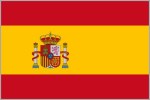
Capital of the Nasrid Kingdom of Granada, last Muslim state in Western Europe, at the foot of the Sierra Nevada

Viva Granada! One of the four primary cities in Spain‘s southern region of Andalucía, Granada was the last outpost of the Moorish rulers of Spain, and probably the best place outside of North Africa to see their exquisite architecture. It sits by the Sierra Nevada, a range of mountains which includes Spain’s highest, Mulhacen.
We visited Granada one cold December weekend, and being entirely unprepared for freezing weather (Spain doesn’t get cold, does it?) one of my first ports of call was the hat shop in the Sierra Nevada ski centre. We stayed in Hostal Gomerez which unfortunately had no central heating, so I ended up wearing my new hat in bed.

Granada is all about the Alhambra, and rightly so, it is the single best preserved example of Moorish architecture in Spain, and no trip to Granada is complete without visiting it, naturally. This was taken from the mirador San Nicolas in the Albaícin, which is permanently chock-a-block with people taking photos of the Alhambra…like me.
One of Granada’s narrow lanes. I spent a while wandering the streets taking pictures of various lanes to try to get one photo which would represent this aspect of the city by itself. I think this does the job.


Calderería Nueva is a street of many touristy Arabic style shops, with all sorts of goodies for the discerning foreigner. It is one of the most interesting little streets I have walked down, full of charm.
One of the shops on Calderería Nueva, full of carpets and various other trinkets I couldn’t identify. I came away with an Aladdin’s Lamp, at a discount because it didn’t come with a genie.


A view from El Generalife towards another part of the Alhambra, the Nasrid Palaces and the Palace of Carlos V. I especially like this photo as the box cut hedges in the foreground mirror the shapes of the palaces behind.
Inside the Nasrid Palaces is a photographer’s paradise. Of the countless shots I took of the beautiful Arabic alabaster carvings I chose this simple shot of a window. The detail and amount of effort that has been put into the walls and the fabric of the palace is astonishing. It is real “Prince of Persia” stuff.


The Court of the Lions is one of the most photographed parts of the Alhambra, an arrangement of water channels and a fountain in the middle of the courtyard supported by eight lions. The single and twin columns supporting the roof number more than one hundred and fifty – Washington Irving told me on the audio tour but I cannot remember for sure.
More beauty of the Alhambra’s Nasrid Palaces, this shot could almost have been taken from underneath the pond on which it is reflected.


The Parador in the Alhambra is part of a chain of many across the country, as it turned out my parents stayed here in 1981 when it was slightly less than the $200 a night required these days. Paradors in Spain are generally old castles or houses which have been converted into hotel-type B&Bs.
Another view of some fancy windows in the Nasrid Palaces, just to give more of an idea of the splendour of the place. Probably the only place I have seen since that comes close, is Topkapi Palace in Istanbul.


The Albaícin is a very old district of Granada, the only part of the Muslim city which escaped destruction when the Moors were expelled in 1492. It has characteristic white houses and a street layout which is the most confusing I have ever had the difficulty of navigating.
Some of the typical houses of the Albaícin, these ones are near to the neighbouring district of Sacromonte, where the houses are built right into the mountain, making use of existing caves. I like the bold simplicity of the colours.


High up in the Sierra Nevada lies Europe‘s most southerly ski centre. The mountain range is accessible by bus from Granada 45 minutes away. Snow had not fallen for two weeks when this picture was taken, you can see how they are trying to maintain the snow cover with cannons, creating the misty effect. The town is at an altitude of around seven thousand feet.
Further up the mountain, there was a more promising covering of snow! Ski lifts run up to nearly the top of Pico Veleta, Spain’s second highest mountain at 3396 metres, and to the neighbouring peak where the Pico Veleta Astronomical Radio Observatory is situated. The observatory is particularly useful at such high altitude where atmospheric interference is minimal. To the left of the dish the T-bar ski lift structures can be seen.


I bring this page to a close with another shot of the Alhambra, this time when the moon was just rising over its battlements. The Alhambra is one of the most photogenic spots I have ever visited, this applies to the rest of the city of Granada as well. I took this about an hour before catching my bus back to Valencia.
Created 2002 | Updated 2015
